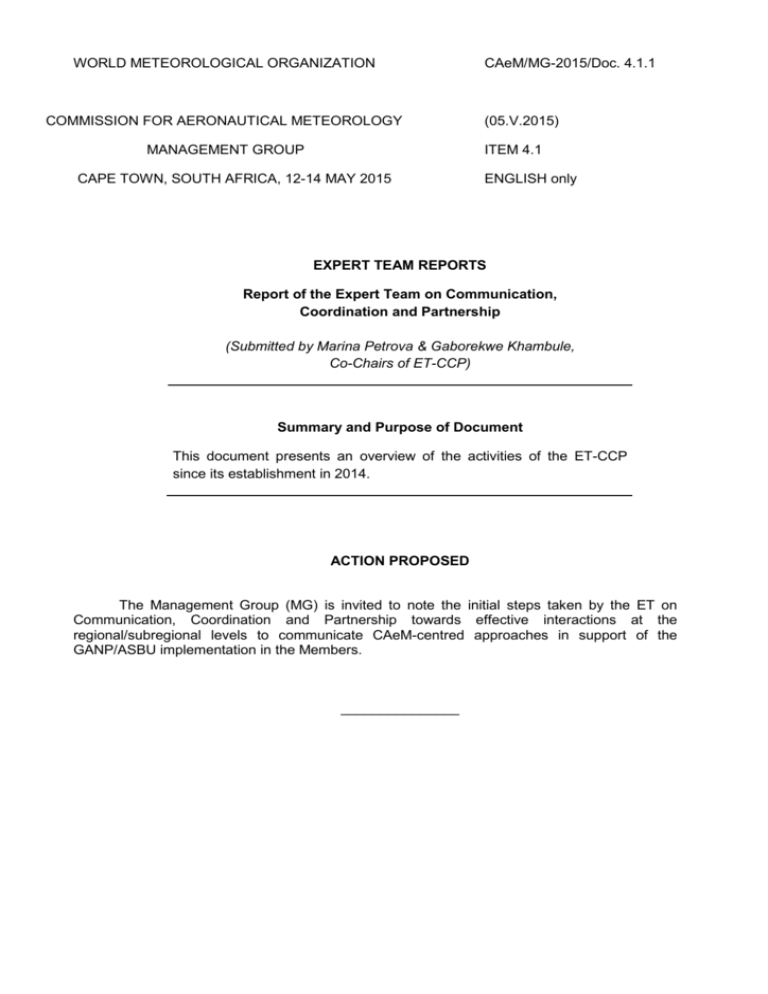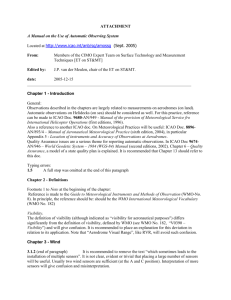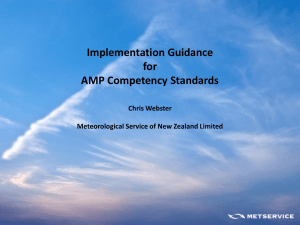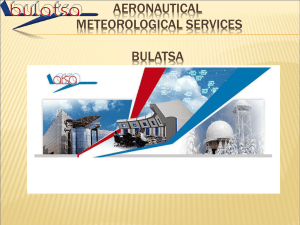Doc. 4.1.1
advertisement

WORLD METEOROLOGICAL ORGANIZATION COMMISSION FOR AERONAUTICAL METEOROLOGY MANAGEMENT GROUP CAeM/MG-2015/Doc. 4.1.1 (05.V.2015) ITEM 4.1 CAPE TOWN, SOUTH AFRICA, 12-14 MAY 2015 ENGLISH only EXPERT TEAM REPORTS Report of the Expert Team on Communication, Coordination and Partnership (Submitted by Marina Petrova & Gaborekwe Khambule, Co-Chairs of ET-CCP) Summary and Purpose of Document This document presents an overview of the activities of the ET-CCP since its establishment in 2014. ACTION PROPOSED The Management Group (MG) is invited to note the initial steps taken by the ET on Communication, Coordination and Partnership towards effective interactions at the regional/subregional levels to communicate CAeM-centred approaches in support of the GANP/ASBU implementation in the Members. _______________ CAeM/MG-2015/Doc. 4.1.1, p. 2 1. EXECUTIVE SUMMARY 1.1 The Expert Team on Communication, Coordination and Partnership (ET-CCP) was set up through the restructuring of the Commission for Aeronautical Meteorology at its fifteenth session (CAeM-XV) held in Montreal, Canada, from 15 to 16 July 2014. The ET-CCP in the new CAeM structure for the period 2014-2018 would coordinate an encouraging response from the Commission to the requests for advice and guidance, enabling the Regional Associations to align their Strategic Operating Plans with the recommendations made at the ICAO/WMO Conjoint meeting in Montreal, including ICAO GANP and ASBU implementation. Monitoring and evaluation (M&E) tools throughout the WMO Regions/sub-regions would be used by ET-CCP to identify gaps/challenges, as well as weaknesses and successes, in the Members in meeting the requirements for enhanced meteorological service delivery arising from the GANP and ASBU strategies. 1.2 The ET-CCP is composed of five core members, with the involvement of non-core members or invited experts who might be helpful in the implementation process. The list of noncore members can be extended for more experts who are seen efficient and able to carry out complementary work. In the current composition the regional representation is as follows: RA I – 3/RA II – 3/RA III – 1/RA IV – 2/RA V – 0/RA VI – 4. A request was made to the President of RA V – Dr Andi Eka Sakya from Indonesia to nominate an appropriate expert or experts for inputs to our team. 1.3 Within the period 2014-2018 the following activities would be of prime importance for the team: To ensure coordination between CAeM, Regional Associations and partner organizations through regional aviation task teams/subgroups on issues of service improvements; To establish a two-way communication mechanism with the relevant RA teams to provide sound advice and clear guidance on AeM-related gaps and challenges arising from GANP and ASBU; To work proactively with aviation task teams/subgroups in the Regions in achieving CAeM OP deliverables in line with the agreed KPTs; To keep the CAeM Management Group informed of the on-going changes in the MET service delivery at the regional/sub-regional levels; To identify the regional gaps/challenges in meeting the requirements for enhanced meteorological service delivery in the intersessional period; To develop an effective mechanism for monitoring and evaluation (M&E) of the CAeM work programme in line with the WMO M&E system; To analyse the progress made in the Regions for collection of best practice examples; To facilitate sharing of the best practice examples among the Regions; To mobilize the CAeM resources to improve the current MET capabilities in the Members; To demonstrate the best practice examples in the MET community. CAeM/MG-2015/Doc. 4.1.1, p. 3 1.4 Following the agreement reached by the CAeM Management Group to hold joint ET meetings and the practice established by the CAeM Expert Team on Aviation, Science and Climate and Expert Team on Information and Services for Aviation meeting which already held their 1st meeting in Toulouse, France from 30 March and 1 April 2015, the 1st meeting of the ET-CCP is supposed to be held jointly with the Expert Team on Governance near the end of 2015. 2. PROGRESS/ACTIVITY REPORT Coordination within ET-CCP and with MG 2.1 CAeM ET-CCP Teleconference-1 (2 March 2015) 2.1.1 As long as motivated participation remains high, group dynamics are always successful. Initial activities therefore focused on getting the team experts involved and fostering smooth team relations. The first teleconference called on 2 March 2015 was aimed to clarify team responsibilities and expectations, seek feedback on the items of the work plan and maintain equitable participation. Totally, seven experts participated in the teleconference, including four core experts. The team experts discussed the following issues, namely: a) the Terms of Reference of the ET-CCP based on the MET/DIV-14 Recommendations/CAeM-15 Resolutions; b) the work plan and expert inputs to the work plan implementation; c) interactions with other CAeM ETs, ICAO/IATA aviation task teams/subgroups; d) planning for face to face meetings. 2.1.2 All experts made short introductions, showing acquired meteorological experience in their services and work done in different WMO/ICAO expert/task teams. 2.1.3 The terms of reference of the ET-CCP aligned with the Recommendations of the MET DIV Meeting and the Resolutions of CAeM-15 made in Montreal, Canada, in July 2014 were used as a starting point of encouraging discussions. 2.1.4 The team experts focused on the work plan approved in January 2015, paying special attention to the implementation areas and target stakeholders, which range from WMO Regions to regional/subregional aviation task teams/subgroups. The experts were informed on: Regional officers in all WMO Regions. Updates on the elections recently held during the 16th session of the Regional Association I (Praia, Cabo Verde, 3-9 February 2015) showed that Dr Bah (Guinea), President of RA I, was succeeded by Dr Amos Makarau (Zimbabwe). Priority areas and urgent tasks to be fulfilled to help the Regions meet the GANP and ASBU requirements, including involvement in the regional/subregional projects, participation in the regional/subregional expert teams/groups, collection of best practices examples, provision of advice, consultation and guidance at the meetings/workshops/conferences. 2.1.5 The experts reported accordingly on what was going on in their Regions, i.e.: The RA I report briefed on the recently held sixteenth session of Regional Association I (Praia, Cabo Verde, 3-9 February 2015). The RA II report mentioned two regional events held in end-2014, namely: a) the RA II Expert Group on Aeronautical Meteorological Services Delivery (EG-AeM) (Hong Kong, 10-12 November 2014); and b) the 6th session of Regional Conference on Management of NMHSs in RA II (Asia). In addition, he noted that RA II EG-AeM highlighted regional challenges and set future work directions aimed to address current deficiencies, inter alia, in the QMS implementation and SIGMET issuance, as well as to initiate work on capacity building towards GANP/ASBU strategies. The RECO-6 highly appreciated regional/subregional partnership/twinning projects. The RA III report informed on an AMP competence assessment meeting held in November for sharing competence expertise. ICAO South American (SAM) Office in CAeM/MG-2015/Doc. 4.1.1, p. 4 Lima initiated teleconferences which will be held monthly. Most of the Members in the Region lack National Air Navigation Plans. The RA VI (Western Europe) report reminded of the SES Programme which was designed to harmonize the EU. Indeed, small EU countries are striving to provide much needed regionalized meteorological information. Most coordination work is done through METG/EANPG meetings held in Paris. The RA VI (Eastern Europe) report stressed the importance of holding regional events, like the mentioned above RECO-6 in RA II. The forthcoming regional events– the Aviation Conferences – are scheduled for late 2015 (November?) in RA VI and early 2016 in RA II. 2.1.6 An analysis of the regional/subregional situation brought out the following: 2.1.6.1 RA VI (Eastern Europe) placed an emphasis on the enhanced liaison with regional/subregional aviation task teams/subgroups. As an example, close collaboration continues between the CIS ICH Working Group and the ICAO METG PT/EAST which have already held three joint meetings to scale out the work programme. The joint fourth meeting was scheduled for 31 March – 3 April in Sochi (Russia). 2.1.6.2 Covering agenda items 3 and 4, the Secretariat resumed that the ET-CCP Telecon-1 closed the 1st round of the on-line expert communication in the CAeM ETs. With regard to the ICAO MET Panel, RA VI (Eastern Europe) and RA I updated on the nomination of experts from the Russian Federation and South Africa, whereas the Secretariat pointed out that the 1st meeting of the Panel would take place in Montreal from 20 to 24 April 2015. Further comments were made on initial work under the ET-CCP to establish a network of aviation focal points in the Members and the Regions, as a whole. 2.1.7 As per the Regions, the following updates on regional/subregional aviation bodies were made available: RA I – A subregional task team was set up at the recent RA I/16 to address the GANP/ASBU implementation issues and keep the PRs abreast of the on-going developments. RA II – The RA II EG-AeM is progressing in assessing the regional capabilities and bridging the gaps. RA III – Additional updates on an aviation task team will be made available in the Region soon. RA IV – An aviation task team is set up in Costa Rica which meets this April. RA V – No idea of any appropriate task team. RA VI – The EUMETNET designated a Rapporteur on MET Service Delivery With respect to the Aviation Conference in RA VI, the Secretariat meets with the Organizing Committee in (Vienna) Austria on 21 March. A ministerial meeting takes place in Indonesia (RA V) on 29-30 April which can make relevant decisions. RA III commented on the possibility of holding an Aviation Conference in RA III. 2.1.8 It was suggested to use the Enterprised Social Network (ESN), such as Yammer, to enhance internally communication between the ET members and externally with other organizations/regional or subregional focal points. As an example, the ET-CCP members were informed of an available QMS forum platform set up at Yammer and managed by BoM (Australia) which proved to be a more effective way for discussing relevant issues than emailing. 2.1.9 The core members agreed to hold teleconferences quarterly. The next teleconference was proposed to be held after Cg-17 (Geneva, Switzerland, 25 May – 12 June 2015). CAeM/MG-2015/Doc. 4.1.1, p. 5 Liaison with aviation task teams/subgroups 2.2 The conjoint CIS ICH WG-4/ICAO METG PT/EAST/15 meeting (Sochi, Russian Federation, 31 March – 3 April 2015) 2.2.1 Collaboration and coordination with the regional/subregional task teams/subgroups develop greater awareness of the implementation process, increase tolerance of differences in implementation tools, encourage reflection and feedback. In an effort to enhance the transferability of the current practices, a regular joint meeting of the CIS Interstate Council for Hydrometeorology Working Group – 4 – Meteorological Services for Civil Aviation – and the ICAO Meteorology Group Project Team for the States in the eastern part of the European Region (ICAO METG PT/EAST) was held in Sochi, the Russian Federation, from 31 March to 3 April 2015. 2.2.2 The joint meeting was intended to create a pool of ideas and knowledge, providing the participants with a chance to discuss challenges and successes. It was attended by 40 experts in the field of aeronautical meteorological services from eight Members/States, including Azerbaijan, Belarus, Georgia, Kazakhstan, the Kyrgyz Republic, the Russian Federation, Tajikistan, and Uzbekistan, as team members, as well as from the international and national organizations, such as ICAO, Austro Control, RSHU, IRAM, and, in addition, other MET experts from CIS countries. 2.2.3 The meeting reviewed vital issues of aeronautical meteorological services for aviation users in the airspace of CIS countries, interactions and coordination enhanced through regional cooperation, as well as prospects and trends of meteorological services to aviation. The meeting, recognizing the importance of the delivery of safety-relevant services to civil aviation as a high-priority issue, appreciated the need to align aeronautical meteorological practices available in NMHSs with ICAO/WMO International Standards and to foster regional cooperation in the interests of ICAO/WMO States/Members. The meeting noted with appreciation twenty presentations and rеports, as well as expert interventions. The meeting expressed its satisfaction with the involvement of all the participants in the discussions. 2.2.4 The meeting was pleased to note that in the intersessional period the Members/States addressed the following issues that needed to be continuously reviewed, namely: (a) aviation safety through improved QMS; (b) control of AMP competency assessment in the Members linked to quality standards; (c) capacity building for Doppler radar network in aeronautical meteorological services; (d) support of the “One Sky” concept for international air navigation fostered by the Global Air Navigation Plan (GANP) framework and the aviation system block upgrades (ASBU) methodology. 2.2.5 During the course of the meeting the focus was given to the short-, medium- and longterm enhancement of MET services. It was noted that the GANP explores the need for more integrated aviation planning at both the regional and State level, and addresses required solutions by introducing a consensus‐driven Aviation System Block Upgrade (ASBU) methodology. Since meteorological information will be a key enabler to the enhanced operational efficiency and flight safety, the group members continued work towards the reduction of SIGMET deficiencies in the MWOs and the establishment of advanced meteorological radars. 2.2.6 In the intersessional period the Members have achieved significant improvements in QMS for aeronautical meteorological services, maintaining the level of MET service compliant with the quality standard. After the entry of the new ISO 9001:2015 Standard measures will be taken towards the conformity of QMSs implemented with the new quality standard. Moreover, the meeting agreed that the Members/States currently certified to ISO 9001:2008 would need a transition period to accommodate the introduction of ISO 9001:2015. 2.2.7 In the interests of the aviation safety, the Members dealt with the issues of re-equipment of MET units, increasing the competency of MET staff, upgrading technologies for generation of MET information, including terminal forecasts, flight region forecasts, SIGMET, AIRMET, as well CAeM/MG-2015/Doc. 4.1.1, p. 6 as for briefings with aviation users. On the subject of exchange of OPMET data, the meeting was pleased to note the efforts made by the Members/States for providing reliable, accurate and timely OPMET data. 2.2.8 With regard to competency standards, as part of AMP continuous training, the main focus was given to improving assessment procedures. In addition, methodological assistance was provided within the subregion through sharing of experience and competency assessment documentation between the Members/States representing CIS ICH WG-4/ICAO METG PT/EAST. Active and efficient cooperation was established between Armenia, Azerbaijan, Georgia, Kyrgyzstan and Belarus. 2.2.9 The integration of radar data into aeronautical meteorological services symbolizes a new step towards the compliance with air navigation requirements for higher forecast accuracy and delivery in near-term of hazardous weather data. Doppler radars are getting more commonly used in aeronautical meteorological services worldwide, making the Members/States take actions to put them into operation. Over the last ten years Kazakhstan, Belarus, Azerbaijan, Ukraine, etc. have gained valuable experience in radar data applications. The meeting highly appreciated the progress report from Kazakhstan on the operations of the Doppler radar network and the preparedness of the Russian Federation to establish four Global/Regional Centres, improving the ability to respond to large-scale and high-impact events. 2.2.10 The Technical Regional Officer (EUR/NAT Office) reported on the ICAO recent significant international aviation developments. 2.2.11 The Chair of PT/EAST informed the meeting on MET relevant Decisions and Conclusions made by METG/24 and EANPG/56 held in end-2013 that helped update the Terms of Reference of PT/EAST. 2.2.12 With regard to the ICAO inspection audits the meeting was informed of the recent inspection audits conducted by ICAO experts. The meeting recognized the need for sharing the results of ICAO inspection audits conducted in the Members/States of the subregion to ensure timely preventive actions. 2.2.13 Considering education and training standards in meteorology, the meeting was updated on currently available training materials, resources and all types of computer-assisted learning courseware related to meteorological education and training to meet AMP competency and qualifications standards. Moreover, the reports made highlighted the outcomes of AMP competency assessment. 2.2.14 As regards the English language proficiency for aeronautical meteorological personnel, the meeting welcomed with appreciation the statements made by the Technical Regional Officer (ICAO EUR/NAT Office) and the Chair of PT/EAST, who highlighted the ICAO requirements specifying the necessary English language proficiency level. The meeting expressed the overall concern of meeting the deadline for language proficiency requirements with respect to MET personnel providing briefings and/or consultations to flight crew members and other flight operations personnel. It was felt that the training of personnel to meet the required competency in the English language might be time-consuming and costly, and, therefore, the transition period would be required to make all the appropriate arrangements by the target date. 2.2.15 When addressing the issues of new technologies in support of aeronautical meteorological services, the meeting noted with appreciation the presentations made on the automated forecast verification system which was implemented in the Russian Federation, the airport nowcasting systems, the Doppler radar network in the Republic of Kazakhstan, the adaptation of GIMET-2010 software for the secondary information processing installed at the Doppler radars, wind profiler operations, near-terminal area weather radars. 2.2.16 As regards the SIGMET and AIRMET issuance, the meeting agreed that a concept for the implementation of the Regional Hazardous Weather Advisory Centres (RHWACs) to support the issuance of SIGMET should be developed. Such Centres were supposed to provide CAeM/MG-2015/Doc. 4.1.1, p. 7 information on the occurrence of hazards irrespective of the FIR boundaries, which would reduce in future the differences in forecasting hazardous weather events by adjacent MWOs. The meeting felt that MWOs should apply special automated error elimination software for issuing bulletins. 2.2.17 During the discussions of the States’ actions towards an enhanced QMS, incorporating SMS elements, the meeting welcomed the work being carried out in Astro Control towards further integration of QMS and SMS. The meeting noted with appreciation a number of initiatives related to risk management that introduced, inter alia, safety and security assessments in MET and occurrence management in MET. The meeting appreciated the best practice example of risk assessment in MET delivered by an expert from Azerbaijan. 2.2.18 The meeting emphasized the need of holding a meeting to further discuss the issues concerned. The Russian Federation offered to contribute by hosting such a meeting for the Members/States of the subregion in coordination with and co-sponsored by ICAO. 2.2.19 The meeting reviewed a draft final report and the work plan for 2015-2016 for comments and amendments which would be submitted to METG/25 for approval. 2.3 The Sixteenth Session of Regional Association I (Praia, Cabo Verde, 3-9 February 2015) 2.3.1 During the RA I-16 it was noted that AeM remains one of the top priority areas for the Members of the Region. Given the variety of organizational and institutional structures, the role of ASECNA in providing a regional service delivery mechanism was highly appreciated. The Association expressed concerns of the possible significant implications of the numerous ATM developments on the future MET service provision. The GANP/ASBU implementation process is hampered by the lack of information on the GANP/ASBU requirements and adequate support from the national policymakers and governments. To enhance the capabilities of the national AMSPs the Members are invited to focus on awareness-increasing activities and strengthen regional cooperation. 2.3.2 The Association decided to establish an aviation task team that would monitor all aviation activities in the Region in coordination with appropriate CAeM bodies and assist the Members, inter alia, in the preparation of a regional aviation conference (cf. Draft Resolution 4.1(2)/1 (RA I-16) – Future development of meteorological service provision to civil aviation in Region I (Africa) Doc. 4.1(2) – Aeronautical Meteorology) to initiate GANP/ASBU and SES implementation plans in RA I. 2.4 The ICAO Meteorology Panel meeting and interactions with the newly established Working Groups 2.4.1 The METP meeting recently held in the ICAO HQ resulted in the work programme and the working structure composed of the four working groups. Emphasis is now placed on the need for the CAeM Expert Teams to find out the ways and to what extent the interactions with these groups will be maintained. For the Expert Team on Communication, Coordination and Partnership dealing with best practice examples and guidance materials underpinned by standards and requirements the output from each of the four working groups will be equally valuable. Since the Working Group on MET Requirements and Integration (WG 1) is committed to developing aeronautical requirements and thus to developing a new Procedures for Air Navigation Services – Meteorology (PANS-MET), the ET-CCP will seek close involvement in their work, and at a later stage in the implementation of the PANS-MET. The ET-CCP would anticipate substantial inputs from the Working Group on MET Information and Service Development in the form of data on space weather, volcanic ash, the release of radioactive material, etc. which will be distributed to Members via workshops, seminars and meetings. While arranging GANP/ASBU related workshops in the Regions, dedicated participation of experts from the ICAO Working Groups is seen most helpful. CAeM/MG-2015/Doc. 4.1.1, p. 8 3. ACTION/PLANS/RESPONSIBILITIES WITH DELIVERABLES The ET-CCP work plan was approved in January 2015 and updated in line with new ICAO developments. TEAM Commission WMO Commission for Aeronautical Meteorology (CAeM) Expert Team on Expert Team on Communication, Coordination and Partnership (ET-CCP) Start Date / End Date August 2014 Stakeholders NMHS Aviation Weather Services/Aviation Industry/Regional Aviation TTs/Sub-groups Team Name Organization / Country E-mail Chair / Co-chairs Marina Petrova Gaborekwe Khambule Roshydromet, Russian Federation SAWS, South Africa petrovamv@mail.ru gaborekwe.khambule@weathersa.co.za Core Members Boon Leung Choy Hong Kong Observatory, Hong Kong, blchoy@hko.gov.hk China Collins Osague Nigerian Meteorological Agency, Nigeria metosa3@yahoo.com Kaspar Bucher-Studer MeteoSwiss, Switzerland kaspar.bucher@meteoswiss.ch Cammye Sims-Uskievich, NOAA/NWS, USA cammye.sims-uskievich@noaa.gov Truusje S. Warsodikromo Meteorological Service, Suriname Wtruus98@gmail.com 2018 DESCRIPTION Objective Close liaison with regional/sub-regional aviation task teams/subgroups and partner organizations, including ICAO and IATA; coordination of meteorological service improvements and institutional changes to meet the AeM priority areas and in the light of the ICAO GANP and ASBU-related developments at the regional, sub-regional and territorial levels. Background The Expert Team on Communication, Coordination and Partnership (ET-CCP) succeeded the Implementation Coordination Team (MG-ICT) through the restructuring of the Commission for Aeronautical Meteorology at its fifteenth session (CAeM-XV) held in Montreal, Canada, from 15 to 16 July 2014. The ET-CCP in the new CAeM structure for the period 2014-2018 would coordinate an encouraging response from the Commission to the requests for advice and guidance, enabling the Regional Associations to align CAeM/MG-2015/Doc. 4.1.1, p. 9 their Strategic Operating Plans with the recommendations made at the ICAO/WMO Conjoint meeting in Montreal, including ICAO GANP and ASBU implementation. Monitoring and evaluation (M&E) tools throughout the WMO Regions/sub-regions would be used by ET-CCP to identify gaps/challenges in the Members in meeting the requirements for enhanced meteorological service delivery arising from the GANP and ASBU strategies. Terms of Reference (a) To ensure effective two-way communication with Members and partner organizations, such as the International Civil Aviation Organization and the International Air Transport Association, on issues of concern of the WMO Aeronautical Meteorology Programme; (b) To promote effective communication with the regional associations and coordinate appropriate response to their requests for advice and guidance concerning gaps and challenges in aeronautical meteorological service provision in their respective Regions; c) To establish an effective mechanism for the monitoring and evaluation of the CAeM work programme as an integral part of the WMO monitoring and evaluation system; (d) To provide support to the Secretariat in developing and updating relevant databases with regard to Aeronautical Meteorology Programme entries; (e) To report regularly on progress to the president of the Commission. CAeM/MG-2015/Doc. 4.1.1, p. 10 COMMUNICATION STRATEGIES Description Target Audience Delivery Method Frequency / Date Responsibility Work Plan CAeM MG/ET-CCP Document via email An yearly update from end-2015 M. Petrova G. Khambule General correspondence CAeM MG/ET-CCP Email As required CAeM MG/ET-CCP Team Meetings CAeM ET-CCP or CAeM ET-CCP/ ET-GOV Face-to-face meetings As scheduled by CAeM MG CAeM MG CAeM ET-CCP Teleconference As scheduled by ET-CCP M. Petrova G. Khambule Reports CAeM MG Reports via emails and presentations for MG meetings As scheduled by CAeM MG M. Petrova G. Khambule Final Report CAeM-16 Report via email End-2017 M. Petrova G. Khambule CAeM/MG-2015/Doc. 4.1, p. 11 MILESTONES / WORKPLAN Milestone / Activity / Task ET Accountability Deliverables Dates TORs ACTIVITY 1: UPDATES OF WORK PLAN Milestone 1.1: Consolidated Work Plan MG & ET-CCP 30 Sep 2014 Task 1.1 : Update ET-CCP work plan MG & ET-CCP As required ACTIVITY 2: COORDINATION WITH REGIONAL ASSOCIATIONS (RAS) & PARTNER ORGANIZATIONS, INCLUDING ICAO & IATA Milestone 2.1: Updates on meteorological service improvements and institutional changes arising from the ICAO GANP and ASBU ET-CCP members Task 2.1: Cooperate/liaise with the regional aviation task teams/subgroups & ICAO METP working groups Task 2.2: Make inputs to relevant regional/sub-regional group work plans Marina As required Gabo Task 2.3: Update on the on-going changes in the MET service delivery at the regional, sub-regional and territorial levels CM, Ian, Dimitar, Marina, Gabo As scheduled Task 2.4: Involve regional/ICAO communication/response Dimitar, Scylla, Marina, Gabo As required METP experts for better Status CAeM/MG-2015/Doc. 4.1, p. 12 Task 2.5: Identify regional AeM gaps/challenges, including those related to GANP & ASBU implementation, through questionnaires, gap analysis & RA/TC/ICAO METP liaison experts CM, Ian, Dimitar, Scylla, Marina, Gabo Task 2.6: Identify the on-going pilot projects on the enhanced meteorological service delivery in support of the GANP & ASBU implementation at the regional, sub-regional and territorial levels CM, Ian, Dimitar, Scylla, Marina, Gabo Task 2.7: Provide assistance at the request of the Members to launch relevant pilot projects in support of the GANP & ASBU implementation CM, Ian, Dimitar, Scylla, Marina, Gabo Task 2.8: Monitor & evaluate available technological, financial & human resources for GANP & ASBU implementation Dimitar, Scylla, Marina, Gabo Task 2.9:Coordinate development of regional, sub-regional & territorial databases to support GANP & ASBU implementation CM, Ian, Dimitar, Scylla, Marina, Gabo As required Task 2.10: Provide detailed advice & guidance to RA management groups via CAeM experts CM, Ian, Dimitar, Marina, Gabo As required Task 2.11: Provide input to organization of GANP and ASBU-related workshops and development of pilot projects ET-CCP members ACTIVITY 3: COORDINATION/COLLECTION OF BEST PRACTICE EXAMPLES IN REGIONS Milestone 3.1: Availability of best practice examples in enhanced meteorological service delivery in support of the GANP/ASBU implementation & establishment of SWIM environment on caem.wmo.int website Dimitar, Marina, Gabo CAeM/MG-2015/Doc. 4.1, p. 13 Task 3.1: Identify and collect examples of best practice in enhanced meteorological service delivery to meet the ICAO/WMO SARPs in the AeM key areas and in support of the GANP/ASBU implementation MG, ET-CCP members Task 3.2: Facilitate sharing of best practice examples among the Members Dimitar, Scylla, Marina, Gabo Task 3.3: Provide support to the Secretariat in developing & updating relevant AeM-related databases Dimitar, Scylla, Marina, Gabo ACTIVITY 4: IDENTIFICATION OF RESOURCE MOBILIZATION OPPORTUNITIES Milestone 4.1: Identification of potential agencies/institutions/Members with associated capabilities Members in the GANP/ASBU implementation process to donor assist Dimitar, Marina, Gabo Task 4.1: Identify additional resources available in Regions to assist Members in bridging the gaps/challenges arising from the GANP & ASBU implementation ET-CCP members Task 4.2: Provide consultation with WMO Resource Mobilization Office Dimitar, Scylla Task 4.3: Assess Members’ capabilities in establishing twinning/mentoring schemes to provide assistance to Members experiencing difficulties in the GANP & ASBU implementation All Task 4.4: Determine potential donor Members with capacities available to assist Members in meeting the GANP & ASBU requirements All ACTIVITY 5: COORDINATION WITHIN ET-CCP AND WITH MG 2014-2018 CAeM/MG-2015/Doc. 4.1, p. 14 Milestone 5.1: Organization of CAeM ET-CCP CM, Ian, Dimitar, Marina, Gabo 2014-2018 or CAeM ET-CCP/ET-GOV meetings Task 5.1: Pool & share inputs between the ET members, representing the WMO six Regions ET-CCP members Task 5.2: Make input to organization and conduct of ET-CCP meetings and teleconferences All ACTIVITY 6: As required INPUTS TO WMO COUNTRY PROFILE DATABASE (CPD) Milestone 6.1: AeMP entries to WMO Country Profile Database (CPD) CM, Ian, Dimitar, Marina, Gabo Task 6.1: Coordinate CAeM inputs to develop & update relevant databases in AeMP for the WMO Country Profile Database (CPD) CM, Ian, Marina, Gabo Dimitar, If requested






